- NLI Research Institute >
- A Look at Global Environmental Problems from the Grass Roots Level-The Role of Information in Pro-Environmental Behavior-
A Look at Global Environmental Problems from the Grass Roots Level-The Role of Information in Pro-Environmental Behavior-
Yuko Shozugawa
Font size
- S
- M
- L
| 1. Introduction
Five years after the global summit in Brazil, 1997 is proving to be a milestone for environmental problems: Japan enacted a container recycling law in April, the Special Session of the General Assembly to Review and Appraise the Implementation of Agenda 21 was held in June, and in December Kyoto will host the Third Session of the Conference of the Parties to the United Nations Framework Convention on Climate Change (COP3). While ordinary Japanese seem somewhat less interested in the environment than in the past, this year's developments are sure to deepen grass roots understanding and awareness of environmental problems. In this paper, we look at the role of information in sustaining environmental preservation activities at the grass roots level.
2. Global Environmental Problems and Actions to Preserve the Environment When environmental problems are discussed, people generally think about problems such as waste disposal, air pollution, water contamination, and noise pollution. At the global level, environmental problems include destruction of the ozone layer, global warming, acid rain, destruction of tropical forests, desertification, pollution in developing nations, endangerment of wild life species, ocean pollution, and shipments of toxic waste materials across borders. From an environmental viewpoint, the damage comes from human activities which, from the grass roots level on up to the international level, social and economic systems are not designed properly to control. The characteristics of global environmental problems described in Table 1 are drawn from a report by the Ministry of Finance's Fiscal and Monetary Research Institute entitled "Sustainable Economic Development and Environmental Preservation": (1) the nature of the global environment as a public good, (2) uncertainty of causal relationships and irreversibility of damage, (3) limited effectiveness of symptomatic treatment, (4) equity of burden to future generations, and (5) North/South equity. As members of the global community, each of us must strive to better understand the nature of these problems, and find ways to make the collective impact of our discrete daily actions more effective in preserving the global environment.
|
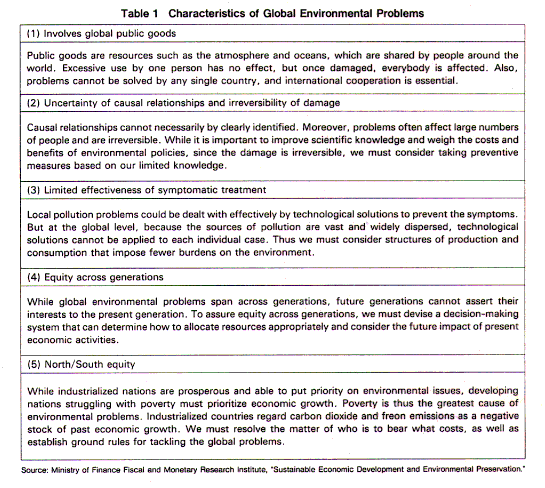
|
3. Environmental Activities and People's Value Systems People today have a variety of value systems, interests, and conflicts. No matter how serious global environmental problems happen to be, people cannot simply abandon their accustomed lifestyles and values and shift to a more environment-friendly mode of life. Moreover, values accepted in society and corporate life often conflict with the aim of preserving the environment. We look once again at data collected in our 1993 survey entitled "Eco-Life Survey of Urban Dwellers," and reanalyzed social values, environmental awareness, and environmental activities. Based on the analysis, we found that certain attitudes positively affect environmental activity (Figure 1): hopes for society's happiness, and does not dislike time, labor and financial burdens (high social awareness); prepares for the future, and wants to see results of own efforts (optimistic, positive); wants stricter laws to protect the environment, wants people to be more serious, wants to educate the public (concerned about moral values); considers impact of environmental problems on future generations (concerned for future generations); and experiences environmental problems as an immediate concern (concerned about immediate problem). Attitudes that negatively affect environmental activity are: wants to be in control of group discussions (leadership oriented); values social status and financial success (success oriented); feels that doing the right thing for society is meaningless if done alone (rationalistic); unconcerned about dangers to the global environment and does not feel personally affected (apathetic). The awarenesses and values that affect environmental behavior either positively or negatively can also work in the opposite direction from what we have suggested. For example, while the desire for leadership in groups was found to work against pro-environmental behavior, if manifested by setting examples of model behavior, disseminating accurate information, and facilitating participation by others, it could also help in building effective organizations that protect the environment. Likewise, people who are apathetic toward environmental problems might become more concerned if they could obtain accurate information on the extent and nature of present environmental problems, and on what is or might be done.
|
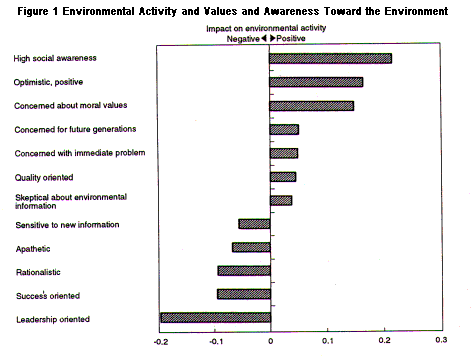
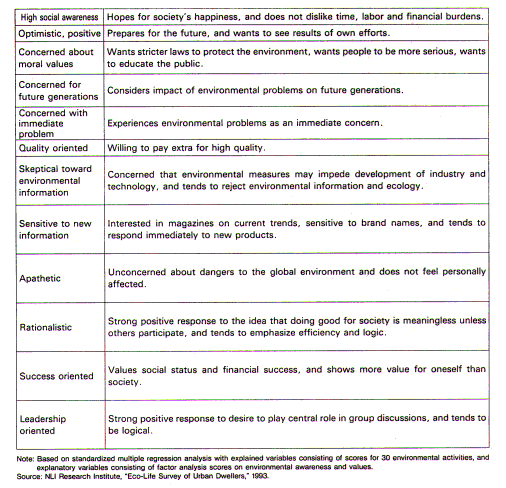
|
4. Information and Environmental Behavior (1) Possession of Information and People's Sense of Involvement Engaging in environmental activity requires a sense of direct involvement, that is, a sense of responsibility as a member of the global community or an awareness of participating in environmental preservation. The National Environment Research Center has conducted an analysis on the relationship between possession of knowledge or information on global environmental problems, and people's sense of personal involvement (Figure 2).
|
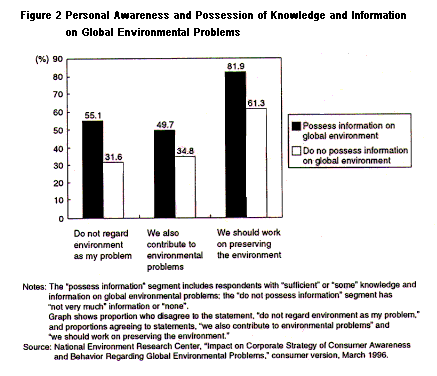
| The analysis classifies respondents into two groups based on whether they possess information/knowledge on global environmental problems. According to the results, respondents who do not possess information agree more strongly with the statement, "Do not regard environment as my problem," while respondents who possess information agree with the statements, "We also contribute to environmental problems," and "We should work on preserving the environment." The results clearly suggest a link between the possession of information and sense of personal involvement.
(2) Slow Progress in Acquisition of Information and Pro-Environmental Behavior The ideal pattern for environmental action is to obtain information, act on the basis of that information, become motivated by the results to encourage others to do the same, and then repeat this virtuous cycle from the individual level up to the community level and global level. We now look at the status of the process from acquiring information to disseminating it among people. The Environment Agency, under the Basic Environmental Plan approved by the Cabinet in December 1994, conducts an annual "Survey of Environment-Friendly Lifestyles" to ascertain the status of pro-environmental activities among the general public. The survey asks respondents to evaluate their own pro-environmental activities in three areas: actively obtaining information on global problems, trying to do pro-environmental activities as much as possible, and encouraging others and otherwise promoting pro-environment activities (Figure 3). Looking at the overall scores, only 22.5 percent of respondents say they "actively obtain information on global problems." On the other hand, a majority of 65.7 percent regard themselves as active and "try to do pro-environment activities as much as possible."
|
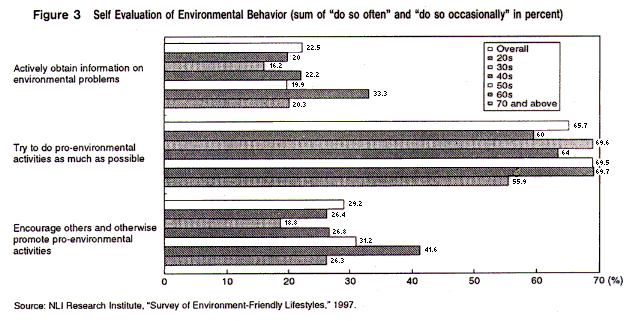
| However, the term "as much as possible" is highly subjective and varies depending on individual opinions and lifestyles. Moreover, only 29.2 percent of respondents engage in the critical area of encouraging and promoting the spread of pro-environmental activities.
Looking at the breakdowns by age segments, what is noticeable is that the 60s segment scores high in all three activities of acquiring information, doing pro-environmental activities as much as possible, and encouraging and promoting their spread, while the 20s segment has low scores particularly in the latter two categories.
5. Supply of Information to Achieve a Sustainable Global Community (1) Types of Environmental Information Needed by People The survey also asked respondents what types of information they need and whether it is available. For all 12 categories of information listed, less than 10 percent of respondents said that information they sought was both available and adequate (Figure 4). The categories of information that were available but inadequate are pro-environmental activities in daily life, effects of environmental problems on daily life, local environment. This suggests that people want to know more about the impact of the environment on their daily lives and what they can do on a daily basis.
|
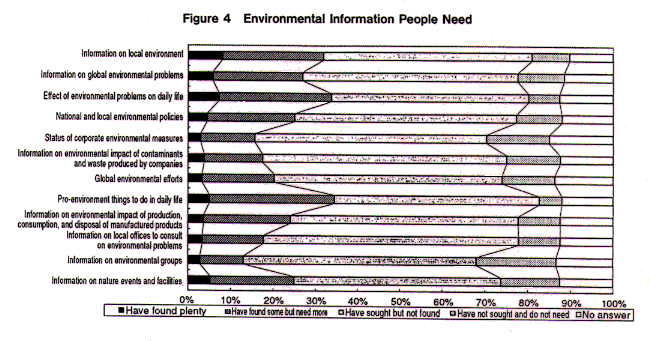
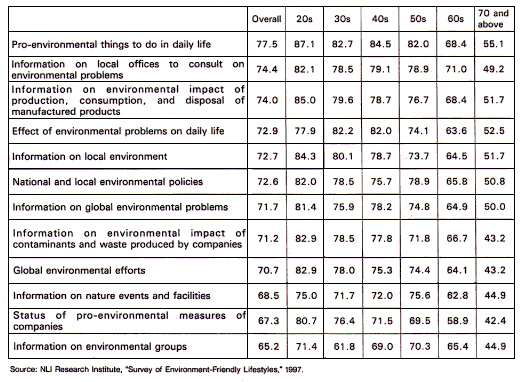
| Information categories that were unavailable but in demand are information on local offices to consult on environmental problems, the environmental impact of contaminants and waste produced by companies, and environmental groups. These categories appear to concern decisions, actions, and participation related to daily pro-environmental activities. Moreover, combining the responses of "have found some but need more" and "have sought but not found," the categories in highest demand are information on pro-environmental activities in daily life, local offices to consult regarding environmental problems, and the environmental impact of contamination and waste from companies. These results indicate that people most want specific information on pro-environmental activities they can do in daily life, and corporate disclosure of environmentally sensitive information.
According to the age segment breakdown, the highest demand for information on the impact of environmental problems on daily life comes from the 30s age segment, while information on nature events and facilities is most demanded by the 50s segment. Overall, the 20s segment had a noticeably high demand for almost all categories, particularly pro-environmental activities in daily life, environmental impacts of production, consumption, and disposal of manufactured products, and the local environment. The younger generation, particularly the 20s segment, has been accustomed to a mass consumption, mass disposal lifestyle since birth. On the other hand, they are the ones who will play a key role in building a sustainable environment-friendly global community in the 21st century. Presently, they cannot be characterized as being particularly active in obtaining environmental information or engaging in pro-environmental activities. However, their strong interest in various categories of environmental information is promising in that if the desired information is supplied through appropriate routes, these people may rise to become leaders of pro-environmental activity.
6. Synergy of Awareness and Action with Information Disclosure and Distribution (1) Information as a Factor Promoting or Impeding Pro-Environmental Activity The previously mentioned survey conducted by NLI Research Institute also covered factors that promote or impede pro-environmental activity. Positive factors include: "energy and water conservation helps the family budget" (economic), "environmental problems are in the news" (topical), "my actions can help preserve the environment" (information on cause and effect), and "recycling systems are available" (convenient access to action). On the other hand, negative factors that impede pro-environmental activity include: "my actions alone won't make a difference" (lack of information on the effect of participating), "there are no environment-friendly products or services available" (difficulty of access to action), "don't specifically know what to do" (lack of information on methods). All the factors described above, both positive and negative, point to the important role of information in stimulating awareness and leading to action. (2) Environmental Education to Foster Awareness on a Sustained Basis To promote a more pro-environmental approach to life, people must deepen their understanding and awareness of the relationship between people and the environment. Learning opportunities that impart information and knowledge of the environment must be provided beginning at the formative stage of life. Efforts at environmental education began at the international level with the 1972 UN Conference on the Human Environment in Stockholm, which issued a declaration on the importance of such education. The Belgrade Charter adopted at the 1975 Conference on International Environmental Education presented the following six objectives for environmental education.
In the U.S., under the 1990 Environmental Education Act, the Environmental Protection Agency was given the task of coordinating other federal agencies in developing environmental programs, providing subsidies to environmental education projects, offering training and research opportunities at government institutions to university students and teachers, and establishing environmental education and training associations. In Japan, the 1993 Environment Basic Law recognizes the importance of environmental education and training by designating the promotion of education and training related to environmental preservation as a major policy. The 1997 White Paper on the Environmentstates the objectives of environmental education and training as: (1) to recognize the present status of the environment, (2) to understand the relationship between people and the environment, wherein environmental problems arise from economic activities such as energy consumption and daily activities, (3) to study the need to change society's lifestyles and economic activities, (4) to foster environmental literacy, the ability to practice a way of life that imposes as little a burden on the environment as possible, while being constantly aware of how one's activities affect the environment. Considering that global environmental problems transcend generations and that people's awareness needs to be continually enhanced, environmental education needs to be incorporated widely in households, communities and workplaces. (3) Demand for Disclosure and Distribution of Information In February 1996, a Green Purchasing Network (GPN)1was established consisting of companies, government agencies, consumer groups, and experts to encourage the formation of a market for environment-friendly products and services. Its task is to educate people by formulating basic principles and guidelines, organizing symposiums and conferences, and collecting and disseminating information. The guidelines contain an environmental checklist so that corporate purchasing agents can evaluate products and make purchasing decisions. Since green purchasing increase costs, it has not yet spread to the consumer level. However, if disclosure measures are implemented and people's awareness is aroused, a virtuous cycle could be created by stimulating demand for green products and causing prices to fall. An increasing number of companies are adopting western management methods, putting a high priority on the environment, and disclosing information on environmental targets and results to shareholders, consumers, the mass media, and the Internet. In moving toward solving global environmental problems, as responsible action is increasingly being sought from all economic actors, neither an extreme return-to-nature orientation or purely technological solution are seen as realistic alternatives. Proper decision-making by the general public requires that their right to know be respected by calling for disclosure by government and businesses. When this is realized, there will be a synergistic effect between government, businesses, and the general public that will take environmental preservation to a new level.
Notes
|
Yuko Shozugawa
Research field
レポート紹介
-
研究領域
-
経済
-
金融・為替
-
資産運用・資産形成
-
年金
-
社会保障制度
-
保険
-
不動産
-
経営・ビジネス
-
暮らし
-
ジェロントロジー(高齢社会総合研究)
-
医療・介護・健康・ヘルスケア
-
政策提言
-
-
注目テーマ・キーワード
-
統計・指標・重要イベント
-
媒体
- アクセスランキング

















